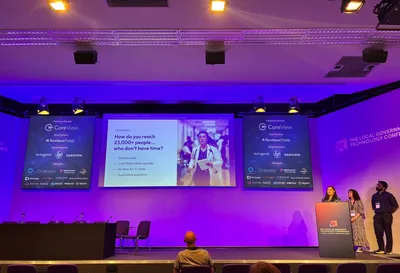AI to scale qualitative research
We're testing AI-powered interviews to reach thousands of NHS staff who don't have time for traditional research methods. Here's what we're learning about scaling qualitative insights while keeping the human element - and why this could transform how public sector organisations listen to their communities.
The background
We're working with Guy's and St Thomas' NHS Foundation Trust to deliver a new intranet for over 23,600 staff across five hospitals and 23 community health centres. To create something that actually works for everyone, we need to understand how people currently find and use information, what frustrates them, and what would make their working lives easier.
When you do user research at that scale, you face a real challenge. How do you properly understand the needs of people who are working night shifts, dealing with emergencies, and generally too busy saving lives to sit in on qualitative research sessions?
At this year's Local Government Technology Conference, we shared an in-progress experiment that tackles this problem.

Emma Halahan, Guy's & St Thomas' NHS Foundation Trust, speaking at the Local Government Technology Conference
The research challenge
At Guy's and St Thomas', staff are doing everything from life-and-death surgery to keeping essential services running.
We could try and do a quick survey, but that won't tell us about behaviour, motivation, or the brilliant workarounds people create. That insight only comes from proper qualitative research. The challenge: how do you scale qualitative insight in a way that still feels human, but meets people where they are?
Our experiment: AI interviews
We're developing and testing an AI interviewer that can run adaptive interviews, that feels like talking to a real person, who's genuinely interested in what you have to say.
- It's mobile-first and voice-enabled - someone can grab five minutes in a break room and just talk to their phone. No scheduling, no finding quiet rooms (text option to follow).
- We're still in charge - we set research goals, design conversation flows, and teach the AI to ask questions the way we would. It's like having a research assistant who can talk to hundreds of people at once.
- It adapts like a human would - if someone gives a short answer, it digs deeper. If they go off on an interesting tangent, it follows that thread.
- Analysis ready outputs - we get audio files and transcripts that we can analyse (currently via NotebookLM).
What we're aiming for
- Scale - hundreds of conversations instead of dozens
- Access - reaching people who've never been heard from before
- Insight - rich, qualitative data grounded in real experiences
We're not replacing human researchers.
This is about adding another tool to our research toolkit. We're still doing traditional interviews, guerrilla research, and focus groups with less digitally confident staff. The AI interviews have clear limitations, they're one tool in a mixed-methods approach.
Doing this responsibly
We're building this ourselves rather than using an off-the-shelf platform, so we have complete control over data storage, consent, and how people's input gets used. We're being transparent about limitations - this isn't a silver bullet. We're sharing what works, what doesn't, and what we're still figuring out.
Where this could go
It's early days, but the possibilities are exciting. Imagine listening to an entire organisation, not just the people who always have time to spare.
There's huge potential for local and central government. Public bodies need to consult with communities constantly, on everything from planning to transport changes to service redesigns.
Currently, consultations often hear from the same engaged voices while missing whole segments of the population. This approach could change that, allowing people to participate during their commute, over lunch breaks, or whenever works for them, potentially in their preferred language.
What we're learning
This isn't just about the tool, it's about changing how we think about qualitative research. We're exploring how to make it more scalable, accessible, and representative of real people's experiences.
The experiment's ongoing, and we're committed to sharing both wins and failures as we learn. If you're interested in chatting about this experimental approach, or facing similar challenges with reaching the people who matter most, we'd love to hear from you.
Thanks to everyone who joined our recent webinar to learn more - you can watch the recording below.

We'd love to discuss the specific research challenges you're facing.
Cassandra Christodolo Senior User Researcher
Get in touch


